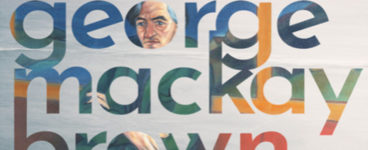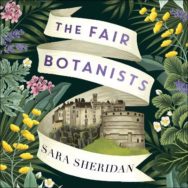‘For me the fascination is always in asking the question: where do we come from?’
It’s the summer of 1822 and Edinburgh is abuzz with rumour of King George IV’s impending visit. In botanical circles, however, a different kind of excitement has gripped the city. In the newly-installed Botanic Garden, the Agave Americana plant looks set to flower – an event that only occurs once every few decades. So begins the tale, and – no spoilers – fantastic read awaits. Author Sara Sheridan tells us more.
The Fair Botanists
By Sara Sheridan
Published by Hodder & Stoughton
Congratulations on the publication of The Fair Botanists. Could you tell us a little more on what you wanted to explore in writing this story?
For me the fascination is always in asking the question: where do we come from? That might be socially or culturally or politically – but that’s always my question. For this novel it was directed at Edinburgh – the city where I’ve lived for years – and exploring what the capital was like two hundred years ago. As a kid I used to visit the Royal Botanic Garden – and as an adult I continued to go there. It’s not far from where I live. So using the Garden as a setting was fascinating to me because in 1822 it moved from a site on Leith Walk to only a few acres initially at Inverleith (these days it’s more than 80 acres). This was a huge process, managed by William McNab, the Head Gardener of the day, who developed new botanical methods to move the larger plants. This is pre-steam – so there is a lot of muscle involved! The largest tree he moved was a 46 foot tall alder. The plants were loaded onto wagons and run up Leith Walk and down what today is Broughton Street, through Canonmills. It must have been quite the sight.
And of course, I’m always interested in the women, so I was interested in looking at the way women interacted with the Garden as an institution, which was at the time part of the University of Edinburgh’s medical school. It’s too early for women to train as doctors but that doesn’t mean it’s a solely male preserve….
Your novel is set in Enlightenment Edinburgh, a period of great change in the city. What drew you to this setting?
By 1822 the Enlightenment is more or less over, to be honest, but there are lots of people still around who lived through that era and of course, they don’t know that Edinburgh is moving away from being Europe’s most important and innovative centre of thought! And it was that that drew me, I think – being on the cusp of change, the New Town being so … well … new. And the ghost of the Jacobite and Hanoverian conflict. Edinburgh was a Hanoverian city but the spectre of Culloden and the Stuarts was still alive if only faintly, and 1822 is the year George IV visited the city. It felt like the nexus of something.
And what draws you to historical fiction? What fascinates you about the past?
This is a great question. I suppose historical fiction is an exciting vehicle to explore our own time. You can’t understand where you are or make good decisions about where you’re going if you can’t see where you’ve come from. So it’s that. Good historical fiction allows you to make that connection on a visceral level – it’s a time machine.
You love the research process for your novels. Was there anything you learned during your research for The Fair Botanists that surprised you?
So many things! I learned a lot about the sex trade in the city during the Georgian period, which was legion! And the way the legal system dealt with (mainly female) sex workers. In that there are echoes that reverberate today into the way women are treated by our culture in the process of rape cases. The patriarchy is still at it!
It was also lovely to explore the connections in my home town – so much of the built environment in Edinburgh is still there, though the city boundary used to be at the Water of Leith. I was also surprised at the level of industry along the water– one of Scotland’s biggest distilleries was at Canonmills and I have one character in the book who works there…
Writing this story felt very playful – and I included some real-life figures like William McNab (and his family), Sir Walter Scott, Robert Graham who was a professor at the University as well as Regius Keeper of the Garden…. Not to forget the women of course – Henrietta Liston appears. Liston is fascinating – she was a botanist in her own right. Her papers are held by the National Library in Edinburgh. And Lady Charlotte Scott (having trouble with her husband, Sir Walter who is obsessed with the king coming to town. It was fun giving all these real-life people personalities on the page – dressing them, giving them carriages and pets and modes of speech, favourite foods and books to read.
I’ve started an Instagram feed for the world of the Fair Botanists – www.instagram.com/thefairbotanists where I’m sharing lots of what I’ve found – Edinburgh history, biographies of interesting characters, botanical stories and the progress of the book. All welcome to follow if any of that is your bag!
Your work always shines a light on women’s stories that history has overlooked. How have these stories shaped your thinking about our shared history?
I’ve always been an equal rights campaigner. I think writing Where are the Women? in 2018 radicalised me though! I knew many of the stories I told already, even I was blown away by the scale on which we have forgotten female achievement over the centuries simply because we have consistently neglected to properly memorialise it. Inserting over a thousand women’s stories into our real life environment (both rural and urban) was an absolute honour – even if the monuments were mostly imaginary. In Fair Botanists one of the big pleasures was creating a world where women were included, so when someone reaches for a book I made the decision that the writer would be female (and not only Jane Austen, thank you!), if a market gardener were to be consulted, it was a woman, if a song were sung, it was written by a woman. Because it’s not that women didn’t do these things and weren’t known in their own time – it’s only that we’ve forgotten!
Are there other women from Enlightenment Edinburgh that you’d like to explore in fiction? Or you’d like to see other writers or film makers portray?
Now you’re asking! I mean I have a list! YES. And not necessarily only from the Enlightenment either. There are some cracking painters – a friend has just written a book about Christina Robertson and I’m excited for that story. She ended up as the Court painter in St Petersburg.
We were so pleased to see you add in your passion for perfume in The Fair Botanists. Can you tell us more about what you love about perfume creation?
I think creatives relate to the world through different media and for me, the most immediate media are words, colour and smell. I’ve always been like that. I made my first perfume when I was 10 – it went mouldy because I squeezed in some oranges, but I was not wrong – orange remains one of my favourite scents. For many people scent is absolutely evocative – a whiff can take them back immediately to a certain time or place.
So when I created the character of Belle Brodie she was a high-class courtesan but she had the same fascination as I do for smell. Though her interest is in whether she can manipulate people’s behaviour through scent. And yes you can! This tied in with the Georgian fascination for potions – like magic. In fact in 1824 in Edinburgh there was a real-life case of two shop boys who mixed a ‘love potion’ and gave it to a girl. It’s not an uncommon story though looking at that case, it seems more like a ‘rhohypnol’ episode than the grand plan that Belle undertakes.
Perfume is a big part of my world so it was genuinely fun writing directly about that – though there are always smells in my novels, this time I got to the nub of the thing!
You always seem to have exciting projects on the go. What are you working on now?
Thank you that’s very nice of you to say. I’m just starting another novel set slightly later – in the 1840s and mostly in Glasgow. It’s about an early female photographer – a fictional one but she is based on a real-life character. One of the things I’m interested in just now is the differences between Edinburgh and Glasgow and where those differences came from. So far, the research for this book has been a bit of an odyssey! I’m really enjoying it, particularly looking at the female gaze from its inception in photography.
And what are you reading just now? What books have excited you this year?
Well I’m excited cos I’m going on holidays this week and I’m taking Kirstin Innes’s Scabby Queen with me and I know I should have read it by now but somehow it just ended up far too far down my list. No longer. But right now I’m reading the Lighthouse Witches by CJ Cooke which is creeping me out – so scary! It’s out in September. I loved ES Thomson’s Nightshade which came out in the spring – it’s the fourth in her Jem Flockhart series. I’ve also been re-reading the short stories of Lorna Moon which are hands down my favourite short stories ever with the possible exception of some of Damian Runyon’s shorts. It’s such a treat to have time to read right now. I find it difficult to read when I’m writing cos I suck up the other writer’s narrative voice, so I’ve had a couple of months in between commissions and I’ve absolutely dived in and adored it!
The Fair Botanists by Sara Sheridan is published by Hodder & Stoughton, priced £16.99
ALSO IN THIS ISSUE

 Beyond the Swelkie
Beyond the Swelkie
‘Quiet meditations, the start of a lovely dawn / broken, piece by piece as day breaks.’














